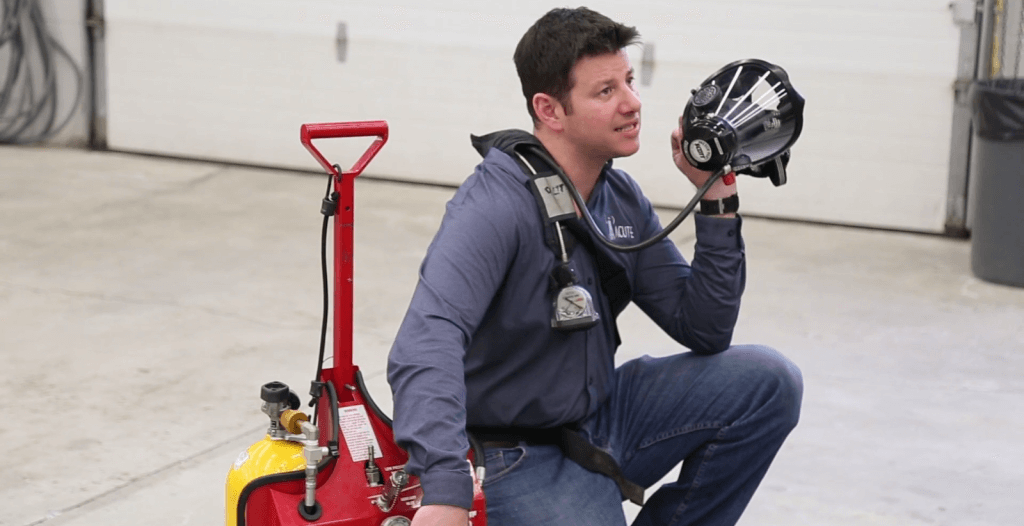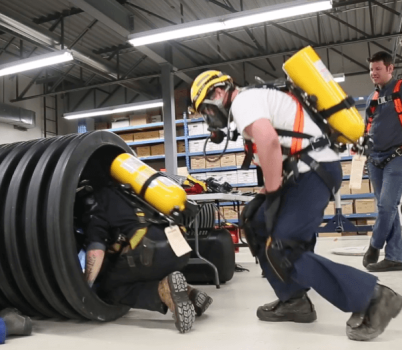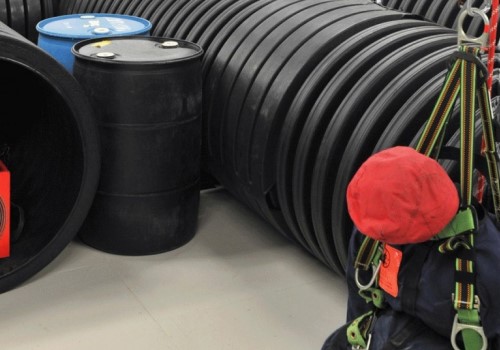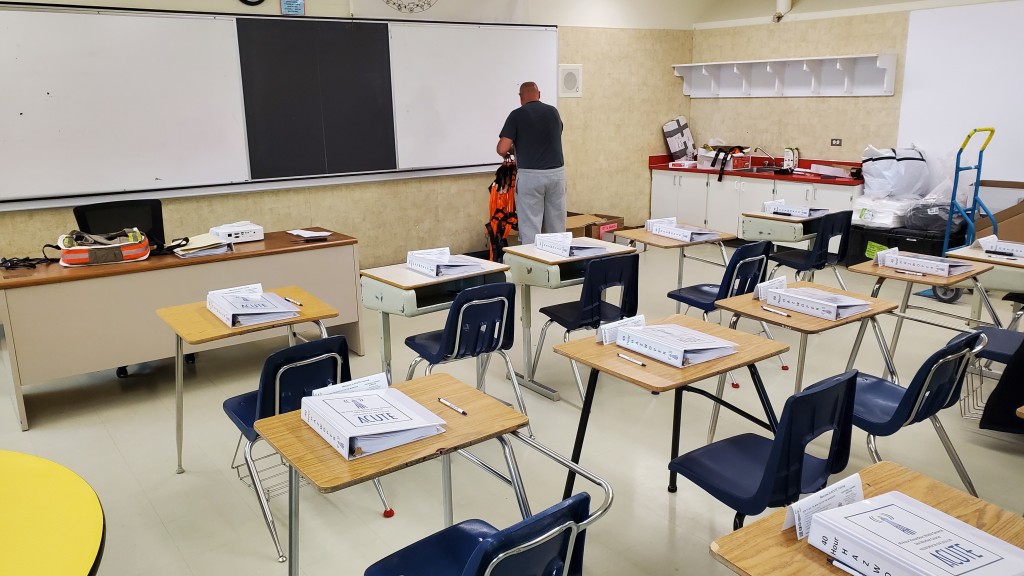A confined space rescue plan is a crucial document for any organization that has confined spaces. It outlines the procedures and protocols to be followed in the event of an emergency within a confined space.
Here’s a step-by-step guide to creating a comprehensive confined space rescue plan.
- What Is A Confined Space Rescue Plan?
- Identify Confined Spaces
- Conduct a Risk Assessment
- Develop a Rescue Plan
- Training and Drills
- Review and Update
Are you implementing or updating a confined space rescue plan? Receive the proper training with ACUTE. We offer a variety of courses at our World Class Health and Safety Training Center including Confined Space Entry Awareness and Confined Space Rescue.
Contact us today to learn more.
1. What Is A Confined Space Rescue Plan?

A confined space rescue plan is a necessary protocol for any organization where employees may be subjected to working in confined spaces.
A confined space rescue plan is a critical safety document designed to protect workers in hazardous environments. These spaces, such as tanks, silos, and manholes, are often enclosed, poorly ventilated, and can pose serious risks like:
Flammable Atmospheric Hazards: These hazards arise from the presence of flammable or explosive gases, which can ignite and cause fires or explosions.
Toxic Atmospheric Hazards: These hazards occur due to exposure to harmful substances in the air. This can include asphyxiation from a lack of oxygen or inhalation of toxic gases, vapours, fumes, or dust.
Physical Hazards: Physical hazards involve potential injuries from factors such as falls, impacts from falling objects, or entrapment by equipment.
Engulfment Hazards: Engulfment occurs when a person becomes submerged in substances like liquids (water, oil) or solids (dirt, grain). This can lead to drowning or suffocation.
Canadian regulations, such as those outlined by the Canadian Centre for Occupational Health and Safety (CCOHS), mandate the development and implementation of confined space rescue plans. These plans are essential for ensuring worker safety and compliance with regulatory requirements.
By prioritizing safety and adhering to best practices, organizations can mitigate risks and protect their workforce.
2. Identify Confined Spaces
Confined spaces pose significant safety risks due to their inherent limitations and potential hazards. To effectively manage these risks, it’s crucial to accurately identify and assess all confined spaces within your workplace.
A confined space is defined as any space that:
- Is large enough for a person to enter and work
- Has limited or restricted means of entry and exit
- It is not designed for continuous occupancy
To ensure comprehensive risk management, create a detailed inventory of all confined spaces on your site. This inventory should include information such as:
- Location: Precise location of the confined space within your facility.
- Dimensions: Size and shape of the space.
- Potential Hazards: Identification of potential hazards, including atmospheric hazards (toxic gases, oxygen deficiency), physical hazards (falling objects, electrical hazards), and biological hazards.
- Access Points: Location and condition of entry and exit points.

Start by identifying any confined spaces within your workplace.
3. Conduct a Risk Assessment
Once you’ve identified your confined spaces, the next crucial step is to conduct a thorough risk assessment. This process involves identifying potential hazards, evaluating their severity, and implementing control measures to minimize risk.
- Hazard Identification: Identify all potential hazards associated with each confined space, such as atmospheric hazards (toxic gases, oxygen deficiency), physical hazards (falling objects, electrical hazards), and biological hazards.
- Risk Evaluation: Assess the severity of each hazard and the likelihood of exposure.
- Control Measures: Develop and implement control measures to minimize risks, such as ventilation, personal protective equipment (PPE), and emergency procedures.
4. Develop a Rescue Plan
A comprehensive confined space rescue plan is essential to ensure the safety of workers in the event of an emergency. This plan outlines the procedures and protocols to be followed to safely rescue individuals from hazardous confined spaces.
Key elements of a robust rescue plan include:
- Emergency Response Team: Establish a dedicated emergency response team with trained personnel.
- Emergency Procedures: Develop detailed procedures for:
- Initial Response: Steps to be taken immediately upon notification of an incident.
- Evacuation: Procedures for safely evacuating personnel from the confined space.
- Rescue Operations: Specific techniques and equipment for rescuing an incapacitated worker.
- Post-Incident Procedures: Steps to be taken after the incident, including investigation, cleanup, and equipment maintenance.
- Emergency Equipment: Ensure that appropriate rescue equipment is readily available, such as:
- Personal Protective Equipment (PPE): Hard hats, safety glasses, respirators, and protective clothing.
- Respiratory Protection: Self-contained breathing apparatus (SCBA) and supplied air respirators.
- Confined Space Entry and Rescue Equipment: Tripods, winches, harnesses, and other specialized equipment.

Ensure staff is well-trained and PPE is readily available.
5. Training and Drills

Make sure your employees receive updated training and regular drills.
To ensure the effectiveness of your confined space rescue plan, it’s crucial to invest in ongoing training and regular drills. These activities will help your emergency response team maintain proficiency and readiness.
Key components of a comprehensive training program include:
- Regular Training Sessions: Conduct frequent training sessions to familiarize team members with:
- Confined space hazards and risks
- Rescue techniques and procedures
- Use of specialized rescue equipment
- Emergency communication protocols
- Periodic Drills: Simulate real-world scenarios through drills to test the team’s response time, coordination, and decision-making abilities. Drills also help identify potential weaknesses in the plan and equipment.
6. Review and Update
To maintain the effectiveness of your confined space rescue plan, it’s essential to conduct regular reviews and updates. This proactive approach ensures your plan remains relevant and aligned with evolving industry standards and regulatory requirements.
Key aspects of the review and update process include:
- Annual Review: Conduct a yearly review to assess the plan’s accuracy, completeness, and effectiveness.
- Updates: Update the plan whenever there are changes in:
- Confined space operations
- Emergency response procedures
- Rescue equipment
- Regulatory requirements
By following these steps, you can create a comprehensive confined space rescue plan that will help protect your workers and minimize the risk of accidents.
Remember, a well-prepared and well-executed rescue plan is essential for the safety of your workforce.
Elevate Your Safety Training With ACUTE
Creating A Confined Space Rescue Plan? Experience world-class training with real-world simulations. ACUTE’s state-of-the-art facility offers immersive training in confined spaces, working at heights, HAZWOPER and more!
Our team’s 200+ years of experience ensure you get actionable solutions, not abstract theories.


